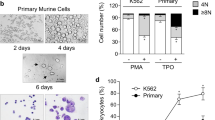Culturing of bone marrow cells in serum-free RPMI-1640 medium led to a decrease in the rate of DNA biosynthesis. Addition of HDL or their main protein component apolipoprotein A-I to the culture medium dose-dependently increased the rate of [3H]-thymidine incorporation into DNA. The maximum stimulation was achieved at HDL concentration of 80 μg/ml and apolipoprotein A-I concentration of 20 μg/ml. To identify the target-cells of apolipoprotein A-I, we used thymidine analogue 5-ethynyl-2’-deoxyuridine (EdU) that incorporates into cell DNA at the stage of replicative DNA synthesis (S phase) and can be detected by fluorescence microscopy. In bone marrow cell culture, apolipoprotein A-I stimulates the proliferation of monocyte (monoblasts, promonocytes) and granulocyte (myeloblasts, promyelocytes) progenitor cells, as well as bone marrow stromal cells.
Similar content being viewed by others
References
Goldberg ED, Dygai AM, Shakhov VP. Methods of Tissue Culture in Hematology. Tomsk, 1992. Russian.
Panin LE, Khar’kovskii AV, Usynin IF, Tuzikov FV, Tuzikova NA. Effect of tetrahydrocortisol-apolipoprotein A-I complex on protein biosynthesis in hepatocytes and on the secondary structure of eukaryotic DNA. Mol. Biol. 1999;33(4):596-601.
Panin LE, Usynin IF, Khar’kovskii AB, Poteryaeva ON. Effect of high-density lipoproteins and hydrocortisone on apolipoprotein E production in Kupffer cells. Bull. Exp. Biol. Med. 1998;126(1): 679-680.
Panin LE, Khoshchenko OM, Usynin IF. Role of apolipoprotein A-I in steroid-induced activation of DNA and protein synthesis in hepatocytes. Bull. Exp. Biol. Med. 2001;131(1): 50-52.
Pykhtina MB, Ivanov ID, Beklemishev AB. Development of effective ways of apolipoprotein A-I isolation from human plasma. Biofarmatsevt. Zh. 2012;4(6):37-45. Russian.
Andrew SM, Titus JA. Purification of immunoglobulin G. Curr. Protoc. Cell Biol. 2001. Chapter 16; Unit 16.3. doi: https://doi.org/10.1002/0471143030.cb1603s05.
Bolliger АP. Cytologic evaluation of bone marrow in rats: indications, methods, and normal morphology. Vet. Clin. Pathol. 2004;33(2):58-67.
Cham BE, Knowles BR. A solvent system for delipidation of plasma or serum without protein precipitation. J. Lipid Res. 1976;17(2):176-181.
Gordon SM, Hofmann S, Askew DS, Davidson WS. High density lipoprotein: it’s not just about lipid transport anymore. Trends Endocrinol. Metab. 2011;22(1):9-15.
Handwerger S, Myers S, Richards R, Richardson B, Turzai L, Moeykins C, Meyer T, Anantharamahiah G.M. Apolipoprotein A-I stimulates placental lactogen expression by human trophoblast cells. Endocrinology. 1995;136(12):5555-5560.
Jin X, Xu Q, Champion K, Kruth HS. Endotoxin contamination of apolipoprotein A-I: effect on macrophage proliferation — a cautionary tale. Atherosclerosis. 2015;240(1):121-124.
Mills GL, Lane PA, Weech PK. The isolation and purification of plasma lipoproteins. Laboratory Techniques in Biochemistry and Molecular Biology: a Guidebook to Lipoprotein Technique. Burdon RH, Knippenberg PH, eds. Amsterdam, 1984. P. 18-116.
Nofer JR. Signal transduction by HDL: agonists, receptors, and signaling cascades. Handb. Exp. Pharmacol. 2015;224:229-256.
Yamato K, Tamasawa N, Murakami H, Matsui J, Tanabe J, Suda T, Yasujima M. Evaluation of apolipoprotein E secretion by macrophages in type 2 diabetic patients: role of HDL and apolipoprotein A-I. Diabetes Res. Clin. Pract. 2005;69(2):124-128.
Zhou X, von Eckardstein A. Effect of HDL and apoAI on PGE2 production by monocyte-derived macrophages. J. Huazhong. Univ. Sci. Technolog. Med. Sci. 2002;22(4):270-272.
Author information
Authors and Affiliations
Corresponding author
Additional information
Translated from Byulleten’ Eksperimental’noi Biologii i Meditsiny, Vol. 164, No. 9, pp. 285-288, September, 2017
Rights and permissions
About this article
Cite this article
Usynin, I.F., Dudarev, A.N., Gorodetskaya, A.Y. et al. Apolipoprotein A-I Stimulates Cell Proliferation in Bone Marrow Cell Culture. Bull Exp Biol Med 164, 308–311 (2018). https://doi.org/10.1007/s10517-018-3978-0
Received:
Published:
Issue Date:
DOI: https://doi.org/10.1007/s10517-018-3978-0




